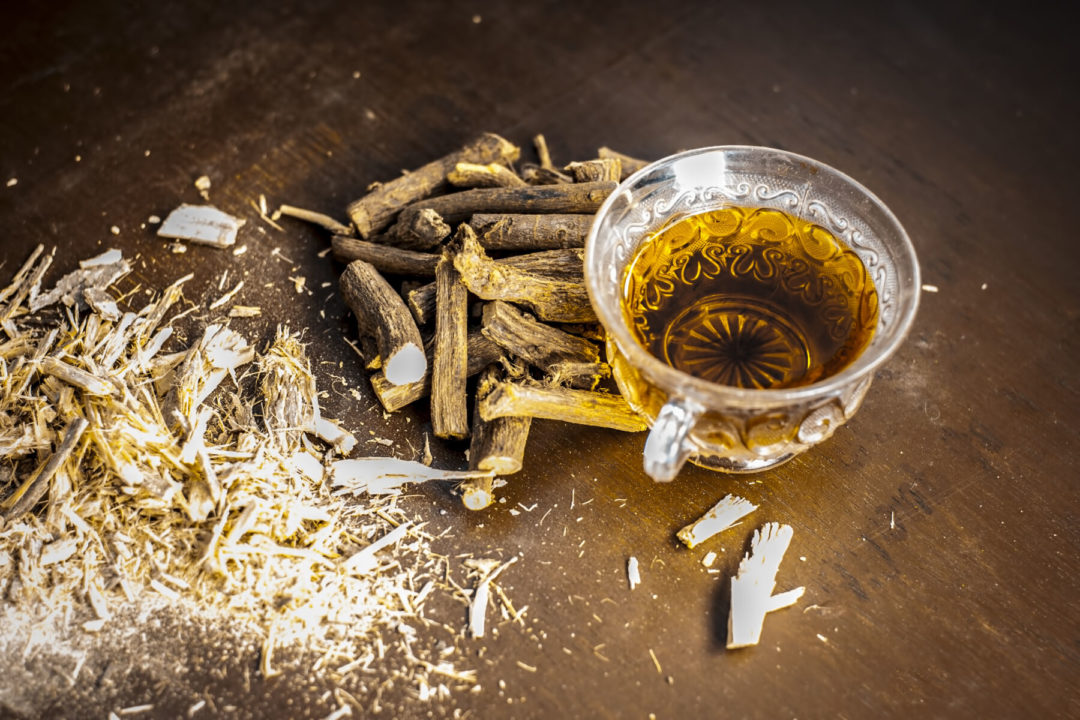
Home » Licorice Root
Licorice Root

January 22, 2021
Licorice root is one of the world’s oldest herbal remedies. Its botanical name comes from the Greek words meaning sweet root. Greeks, Chinese, Hindus, and Egyptians recognized the medicinal qualities of the plant. Native to southern Europe and Western Asia, licorice is part of theLeguminosaefamily.
Traditionally licorice has been used for its antiviral, anti- inflammatory, and antimicrobial properties (1). It is considered to be a successful demulcent that helps to soothe irritated membranes. Licorice is commonly used to support the respiratory tract, helping with chest congestion, and to loosen and expel excess mucus.
The licorice root’s active compound is glycyrrhizin, which gives licorice its sweet flavor; it is known to be 50 times sweeter than sugar. However, glycyrrhizin is also linked to many of the adverse effects of licorice root. As a result, some products use deglycyrrhizinated licorice (DGL) (2).
A small study published inEvidence-Based Complementary and Alternative Medicinefound that deglycyrrhizinated licorice (DGL) is a safe and effective alternative to over-the-counter stomach ulcer medications (3). In a 30-day study of 50 adults with indigestion, taking a 75mg licorice capsule daily resulted in significant improvements in symptoms, compared with the placebo (4).
Licorice is available in forms including extracts, dried roots, tablets, capsules, blended nutritional formulations, and condition-specific formulas.
As always, it is important to consult a medical practitioner before taking licorice. It is suggested that pregnant and breastfeeding women not use licorice. Licorice may cause reactions with some medications. Licorice has been known to increase potency of corticosteroids, and increase blood pressure, thereby lowering effects of blood pressure medications, and diuretics.
References
1) US National Library of Science National Institutes of Health The antiviral and antimicrobial activities of licorice, a widely-used Chinese herb Acta Pharm Sin B. 2015 Jul; 5(4): 310–315. Published online 2015 Jun 17. Doi: 10.1016/j.apsb.2015.05.005
2) US National Library of Science National Institutes of Health Licorice abuse: time to send a warning message Ther Adv Endocrinol Metab. 2012 Aug; 3(4): 125–138. doi: 10.1177/2042018812454322
3) US National Library of Science National Institutes of Health An Extract of Glycyrrhiza glabra (GutGard) Alleviates Symptoms of Functional Dyspepsia: A Randomized, Double-Blind, Placebo-Controlled Study Evid Based Complement Alternat Med. 2012; 2012: 216970. Published online 2011 Jun 16. doi: 10.1155/2012/216970
(4) US National Library of Science National Institutes of Health An Extract of Glycyrrhiza glabra (GutGard) Alleviates Symptoms of Functional Dyspepsia: A Randomized, Double-Blind, Placebo-Controlled StudyEvid Based Complement Alternat Med 2012; 2012:216970. doi: 10.1155/2012/216970. Epub 2011 Jun 16.
Traditionally licorice has been used for its antiviral, anti- inflammatory, and antimicrobial properties (1). It is considered to be a successful demulcent that helps to soothe irritated membranes. Licorice is commonly used to support the respiratory tract, helping with chest congestion, and to loosen and expel excess mucus.
The licorice root’s active compound is glycyrrhizin, which gives licorice its sweet flavor; it is known to be 50 times sweeter than sugar. However, glycyrrhizin is also linked to many of the adverse effects of licorice root. As a result, some products use deglycyrrhizinated licorice (DGL) (2).
A small study published inEvidence-Based Complementary and Alternative Medicinefound that deglycyrrhizinated licorice (DGL) is a safe and effective alternative to over-the-counter stomach ulcer medications (3). In a 30-day study of 50 adults with indigestion, taking a 75mg licorice capsule daily resulted in significant improvements in symptoms, compared with the placebo (4).
Licorice is available in forms including extracts, dried roots, tablets, capsules, blended nutritional formulations, and condition-specific formulas.
As always, it is important to consult a medical practitioner before taking licorice. It is suggested that pregnant and breastfeeding women not use licorice. Licorice may cause reactions with some medications. Licorice has been known to increase potency of corticosteroids, and increase blood pressure, thereby lowering effects of blood pressure medications, and diuretics.
References
1) US National Library of Science National Institutes of Health The antiviral and antimicrobial activities of licorice, a widely-used Chinese herb Acta Pharm Sin B. 2015 Jul; 5(4): 310–315. Published online 2015 Jun 17. Doi: 10.1016/j.apsb.2015.05.005
2) US National Library of Science National Institutes of Health Licorice abuse: time to send a warning message Ther Adv Endocrinol Metab. 2012 Aug; 3(4): 125–138. doi: 10.1177/2042018812454322
3) US National Library of Science National Institutes of Health An Extract of Glycyrrhiza glabra (GutGard) Alleviates Symptoms of Functional Dyspepsia: A Randomized, Double-Blind, Placebo-Controlled Study Evid Based Complement Alternat Med. 2012; 2012: 216970. Published online 2011 Jun 16. doi: 10.1155/2012/216970
(4) US National Library of Science National Institutes of Health An Extract of Glycyrrhiza glabra (GutGard) Alleviates Symptoms of Functional Dyspepsia: A Randomized, Double-Blind, Placebo-Controlled StudyEvid Based Complement Alternat Med 2012; 2012:216970. doi: 10.1155/2012/216970. Epub 2011 Jun 16.
Related Articles

Dr. Jeffrey Burke is a Naturopathic Practitioner, a Master Herbalist, National Educator, and Host of the Honest Health Podcast with Jeffrey Burke.
www.drjeffreyburke.com
Recommended For You
Most Popular
The Magazine
Information
About Us
NOTE: WholeFoods Magazine is a business-to-business publication. Information on this site should not be considered medical advice or a way to diagnose or treat any disease or illness. Always seek the advice of a medical professional before making lifestyle changes, including taking a dietary supplement. The opinions expressed by contributors and experts quoted in articles are not necessarily those of the publisher or editors of WholeFoods.
© Copyright 2025 WFC, Inc. All Rights Reserved.







